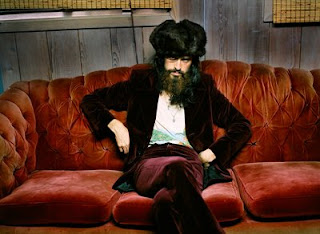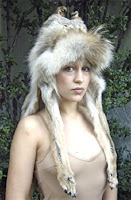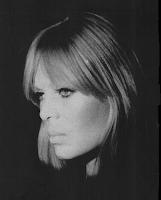 Katrina, Narissa, and Amelia Nields, Clearwater Folk Festival, 2005
Katrina, Narissa, and Amelia Nields, Clearwater Folk Festival, 2005
As a volunteer for performer check-in at Falcon Ridge Folk Festival for several years, I had the rare privilege of meeting the children of several notable folk musicians, from Lucy Kaplansky's adopted daughter to Katrina Nields' newborn. Seeing my favorite musicians up close and personal was always a treat. But seeing folk musicians in parenting mode always felt like peering behind the curtain of the public persona to something real. And once you see that part of a musician, it flavors the way you hear their songs from that day forward.
The confessional, personal nature of folk music lends itself well to songs of family and parenthood; as I've written about previously, I have a special fondness for music which speaks to that side of life. But it's got to be especially difficult to be a mother who makes her living out of music. Working mothers have it hard no matter what, but musicianship isn't like other careers: the late-night shows, the marathon recording sessions, the constant need for one more focused, childless hour crafting song, all stand in tension with the closeness and availability good parenting demands of us.
Yet the folkworld is full of female musicians who -- with or without the help of sensitive, often stay-at-home dads -- work their touring schedules around the various and sundry blessings of childrearing, from nursing and naps to school plays and graduations. Previously featured folkmothers include Caroline Herring, Lucy Kaplansky, Rani Arbo, Shawn Colvin, and Cindy Kallet: some of my favorites, and a significant percentage of the women who we've featured here on Cover Lay Down.
I can't imagine what it must be like to sing a song to your child in front of ten thousand people, or, like Dar Williams did at Falcon Ridge last year, to bring them up on stage, so they can see what you see. And I can't imagine what it must be like to give birth, or to head out on tour for a week without your child.
But I trust that the blogworld is surely swimming with songs about mothers this weekend. And in the midst of all that, I thought it was important to remind us all that the reason we're here, on Mother's Day and every day, is because a few daring, real people -- people with families, with hopes and fears, with love enough to share -- have chosen to make their living making the music that fills our world. And, notably, this is a career path where neither family health insurance nor maternity leave policies are the norm.
Today, as a tribute to working moms everywhere, we bring you some coversongs of and from a few more singer-songwriters with children of their own. As always, if you like what you hear, please support these artists and their families by purchasing their albums, heading out to their shows, and treating them as real people whenever possible.
 Lori McKenna was already a mother of three when she stepped in front of her first open mic audience at the age of 27; since then, she has spent most of her career playing part-time in the local New England folk circuit, staying close to home while slowly making a name for herself with a growing set of well-crafted songs that celebrate the simple pleasures of life as a struggling middle class homemaker.
Lori McKenna was already a mother of three when she stepped in front of her first open mic audience at the age of 27; since then, she has spent most of her career playing part-time in the local New England folk circuit, staying close to home while slowly making a name for herself with a growing set of well-crafted songs that celebrate the simple pleasures of life as a struggling middle class homemaker.
Though McKenna recently turned country, resetting her down-to-earth lyrics to a newly countrified sound and touring as an opening act for Faith Hill and Tim McGraw, her long tenure in the folkworld and her constant celebration of a vividly real motherhood earns her the lead-off spot on today's list. We featured McKenna sideman Mark Erelli's cover of McKenna's Lonestar earlier this week; here's a gritty lo-fi take on Radiohead's Fake Plastic Trees from The Kitchen Tapes, and a much more polished but no less authentic look back at Peter Gabriel's In Your Eyes from out of print American Laundromat compilation High School Reunion.

For a while there,
Suzanne Vega was on the fast track to become the most prolific and popular folk musician to come out of the second-wave Greenwich Village folk scene in the early eighties; she is probably best known for
Luka, her late 80s hit about a neighbor's abused child. But if you haven't heard much from her in a decade or so, it's because she decided to curtail her touring and recording significantly in 1994 in order to focus on her family after her daughter Ruby was born. Since then, she has produced only three albums of new material; the songs have gotten even more introspective, but her quality hasn't suffered one bit.
Here's Vega's take on two delicate songs about children from Grateful Dead tribute album
Deadicated, plus some great duet work with John Cale on an old Leonard Cohen standard.

Urban folk feminist
Ani DiFranco is a relatively new mother and ferocious touring machine who has taken a non-traditional path to motherhood even for the musicworld; instead of taking a hiatus to focus on recording and parenting, as so many other musicians have done, Ani brings her daughter with her as she tours. The model seems to be working -- Ani and family just made the cover of the most recent issue of
Mothering magazine -- but other than
this concert video of new song Present/Infant from her new DVD
Live at Babeville, Ani has not yet recorded any of the new songs about motherhood which she has performed at her recent shows. So here's a few random covers of Ani DiFranco songs, including a great version of
Joyful Girl, a song DiFranco wrote to honor her own mother, performed by jam band Soulive with Dave Matthews.

A swollen belly and a June due date make Massachusetts-based singer-songwriter and folk producer
Kris Delmhorst an impending member of the folk musician mother club, but motherhood is already starting to affect her career; she was showing when I saw her at the Iron Horse a few months ago, and these days, she's rushing through a few dates in support of her new and absolutely stunning album
Shotgun Singer before she goes on family leave. We've played cuts from Delmhorst here before, in recognition of her work with
Peter Mulvey and father-to-be
Jeffrey Foucault as part of folk trio
Redbird; today, it's Kris' turn to glow with this fine, twangy interpretation of an old spiritual tune, and a sweet collaborative turn on Tom Waits' Hold On.
Thanks to folkmusic.about.com for their feature on Folk Music Moms, which served as today's writing prompt. For more about volunteering at Falcon Ridge this July, check out the festival website. Oh, and if you're reading this, Happy Mother's Day, Mom.



















 Lori McKenna
Lori McKenna For a while there,
For a while there,  Urban folk feminist
Urban folk feminist  A swollen belly and a June due date make Massachusetts-based singer-songwriter and folk producer
A swollen belly and a June due date make Massachusetts-based singer-songwriter and folk producer 

 There are surprisingly few songs about the teaching profession which portray it in a positive light (though there are a couple of other memorable songs out there about teachers as sex objects, such as Police classic Don't Stand So Close To Me and Rufus Wainwright's The Art Teacher); of these, fewer still have been covered by folk artists. More common are songs about school as a part of adolescent or childhood experience -- songs where the teachers are there, unmentioned, just hovering in the background. But as a teacher myself, I know that no classroom feels safe unless the teacher has set a tone that makes it safe. Even without mention, as long as curriculum and classroom exist, a teacher is always there.
There are surprisingly few songs about the teaching profession which portray it in a positive light (though there are a couple of other memorable songs out there about teachers as sex objects, such as Police classic Don't Stand So Close To Me and Rufus Wainwright's The Art Teacher); of these, fewer still have been covered by folk artists. More common are songs about school as a part of adolescent or childhood experience -- songs where the teachers are there, unmentioned, just hovering in the background. But as a teacher myself, I know that no classroom feels safe unless the teacher has set a tone that makes it safe. Even without mention, as long as curriculum and classroom exist, a teacher is always there.



